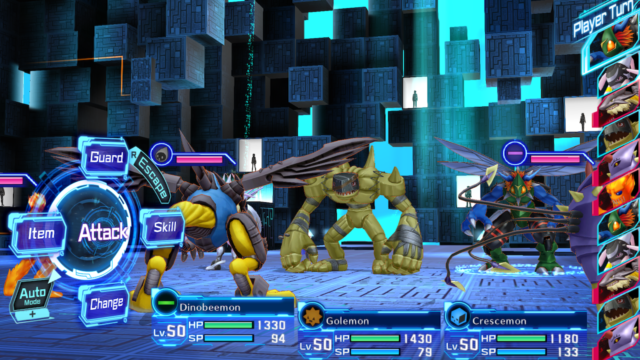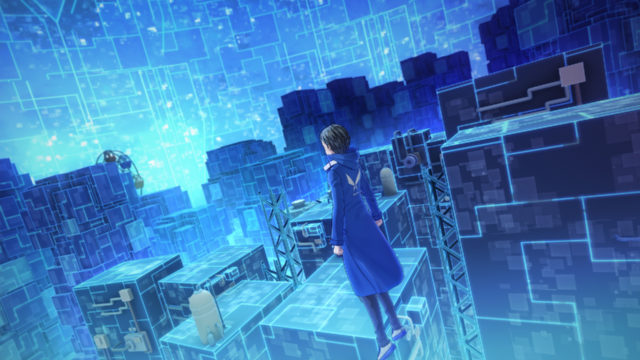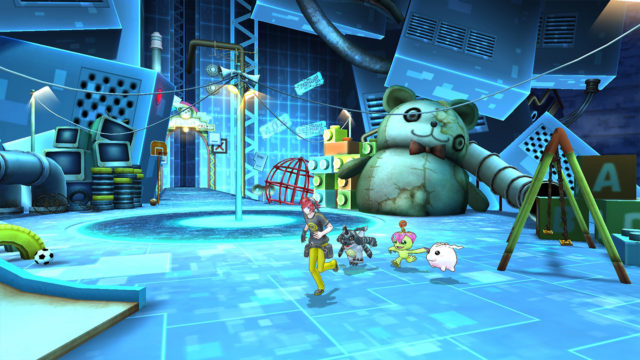Two full JRPGs worth of content; Digimon battles are great thanks to quality animations and solid mechanics; detailed customization and progression systems for your Digimon; main storylines are compelling
Poor pacing due to repetitive and uninteresting filler content; inconsistent presentation during story sequences; lots of repeated assets and designs across both games
With the release of Pokémon Sword and Shield just around the corner, there are undoubtedly many gamers with monster battling and catching on the brain. Nintendo’s beloved franchise remains the undisputed titan of this rather specific subgenre, but it’s not the only game in town- literally. While Pokémon walked away the more popular franchise, Digimon has remained a well-liked series with a dedicated fanbase across the many forms of media it has similarly occupied, and now two of its more recent, and well-received games, have come to Switch in one convenient package.
Digimon Story Cyber Sleuth: Complete Edition is a mouthful containing mouthfuls, as it includes Digimon Stories: Cyber Sleuth and Digimon Stories: Cyber Sleuth – Hacker’s Memory, both of which first saw the light of day on PS Vita in 2015 and 2017 respectively. While they both saw versions released for the considerably more powerful PS4, their older handheld origins must have made them an easy choice for a Switch conversion as Nintendo’s hardware runs both titles perfectly. The only question is really whether or not these games are still worth playing.
The core mechanics at play are more or less identical as they are JRPGs built around collecting and battling monsters or, in this case, Digimon. Naturally, this means you travel across a variety of locales throughout a lengthy story, encountering new creatures and characters as you go. By battling other Digimon, your roster will level up, increasing in power and learning a variety of new abilities and attacks to be used in battle. Where these games differ from similar titles, is in a unique and enjoyable twist to the progression system. As your Digimon reach certain level and stat milestones, you’ll be able to take advantage of the Digi-Evolution mechanic. Digimon come in a variety of tiers that they can move up, or even back down, through this system across a number of optional paths. So, you could choose to evolve a Digimon into an entirely different creature, discover you don’t really like it, devolve it back to the original form, and then choose another. Each evolution does reset the creatures level, but you’ll often gain bonus stats as well as carry over some abilities. This allows for a great deal of experimentation and customization, making it easy for the player to tailor their party to their liking.

Of course, you’ll really get to see the efforts of this customization in the games’ battle system, which is really uniform across both. While you can potentially have up to nine Digimon with you at any time, only three will be able to battle at any given time. Compared to the leveling system, the battle mechanics are much more traditional while still being well executed. The one twist is how most Digimon have two different types to take into account: first is their Digimon type (data, vaccine, and virus) and second is their element (earth, wind, fire, etc.) and each, of course, plays into an advantage/weakness system. For example, a vaccine type has an advantage over a virus, and water has an advantage over fire, which means a Digimon that is vaccine and water, will wreak absolute havoc on one that is virus and fire. Yes, it’s a relatively small twist on the gold standard set by Pokémon, but it’s very much appreciated and works well with the larger party size to help the battles feel unique. The inclusion of a visible order of which creature gets to act in order is another nice bit that helps reinforce the strategic nature of the combat.
Hacker’s Memories adds another little layer to proceedings via Domination battles. In these underutilized encounters, players assume control of three characters (two teammates with preset parties of Digimon in addition to the main character) as they guide them across a game board against three opponents. The goal is to reach a preset point limit by capturing territories in what feels like a turn-based board game. If you or your opponent attempt to take a point held by the other, a standard battle ensues with the winner taking the space. It’s a fairly simple system but It’s still a nice change of pace.
In any good JRPG, combat is just one variable in the grand equation, but unfortunately the other factors don’t fare quite as well. Let’s look at the stories, which overall are fairly decent. In Cyber Sleuth, you assume the role of a teenager (a boy or girl you are free to name) whose first attempts at exploring an all-encompassing VR social, business, and communication network called EDEN leaves them literally disembodied. After an encounter with a strange entity in the digital world, their physical body falls into a comatose state while the data comprising their account is now able to somehow manifest itself both in EDEN as well as in the real world. This predicament leads them to a private detective who can use their unique condition as she serves her clients while also working to figure out how to help our hero. Meanwhile, Hacker’s Memory puts you in the role of another teenager (only male this time) who joins a group of benevolent hackers to track down the bad guys who hacked and exploited his own account. Both tales eventually cross our heroes’ paths with Digimon, whose origins and purpose in EDEN are somewhat of a mystery, as well as strange instances in which the digital world seems to be crossing over with the real world. While not grand, award worthy tales of the human condition, the main plotlines of both games are entertaining enough with plenty of interesting mysteries and exciting revelations to keep your attention. Also, compared to Pokémon, it’s nice to see the Digimon franchise continue its somewhat more mature direction with its willingness to actually deal with things like death and allow its characters to throw out a mild curse word every now and again.

Tragically, the story and general flow of both games takes a hit due to some pacing issues. First of all, Cyber Sleuth takes a long time to really get going as you deal with what feels like hours of exposition and tutorials to establish the plot and mechanics. Hacker’s Memory handles things better as it seems to generally assume a basic familiarity and makes some tutorials entirely optional. But issues continue in both titles as the stories progress and it becomes clear that these games really play out like anime series in that everything is clearly divided into episodic chapters working towards the overall narrative, but occasionally you get what can only be described as filler. Every so often, everything comes screeching to a halt as you handle cases and storylines almost entirely disconnected from everything else that range from moderately amusing, pointless or boring. Most eventually have you dive into a computer to do a little bit of exploration and battling, but the dialogue needed to reach there is the utmost in inane anime drivel. The same can even be said for some more significant story moments, as well. Generally speaking, Hackers’ Memory once again comes out better here as well, though it most certainly remains an issue.
Outside of the interesting combat and inconsistent storytelling, you’re left with exploration gameplay, which really is where you see the cut corners. So much of both games just looks and feels so familiar because most of it literally is the exact same thing, just repeated. You will visit the same locations many, many times, both in the real world and the digital world. Most of the combat exploration occurs in digital dungeons which share the basic aesthetic, and then you’ll often re-enter those same dungeons for side missions and even other later missions. As for the real world, you’ll often be sent to one part of Tokyo (which you’ve already visited a dozen times) to talk with one person before having to go back to where you just came from. In other words, you spend a lot of time running around places that you’ve either been to many times, or that look exactly like other places you’ve been to many times. Worst of all, this problem is actually compounded should you play both games back to back as they actually share many of the same locales and overall design aesthetics.
These issues combine to really hurt the pacing. When you enter a new dungeon or uniquely designed dungeon to progress the main plot, it’s great! But after that, you know you’ll end up with a few more hours where you’ll just be trudging through the same old places to complete some side story you don’t really care about. At points like this, the only thing keeping you going will be the combat and progression systems. Annoyingly, Hacker’s Memory handles these problems a little better, but Cyber Sleuth really should be played first. While they aren’t necessarily direct sequels, Hacker’s Memory does feature plenty of callbacks that benefit prior knowledge of the first game, so to get the full experience you’ll have to trudge through both the good and bad of the whole package. On the plus side, having these two adventures together provides a lot of content as both games are lengthy in their own right. One could easily invest over 100 hours in the whole package.

Lastly, considering the presentation, one shouldn’t be too surprised when they take into account the PS Vita origins. Nothing is pushing the Switch in terms of effects or polygon counts but things generally look clean and reasonably detailed thanks to the anime aesthetic. When the game pulls out one of its prerendered cutscenes, which mix normal and CGI animation, things actually look fantastic, but that’s a very small portion of the game. Much of the story is told through character models lightly animated over static backgrounds with occasional moments of in-engine animation. It’s mostly pretty dull, though once again, Hackers’ Memory comes out ahead with more effort put into the animations throughout these moments. Once again, the game manages to shine in combat as the Digimon themselves are the most detailed models in the game and their attack animations can easily go toe-to-toe with any other turn-based RPG out there: an impressive accomplishment considering there are more than 300 creatures in the game.
The audio is pretty good, as well. The music definitely suffers from repetition as most tracks are reused across both games but there are definitely plenty of fun, memorable tunes among the more generic fare. Overall, the soundtrack does a good job of balancing the synth and industrial styles appropriate for the “Cyber” part of the title, with the jazzier sounds one would expect when thinking about the word “Sleuth.” Voice acting is also present, though it’s only available in Japanese and it sounds quite good for most of the main cast. A few characters fall into some of the more annoying anime tropes which can make for some rather cringey performances, but that’s more a matter of cultural differences. Regardless, a quality English language track would have been appreciated.
Digimon Story: Cyber Sleuth: Complete Edition will likely be an appealing package for plenty of JRPG fans. It certainly offers a wealth of content as it contains two already sizeable games and they even manage to weave some interesting stories while incorporating good gameplay ideas. Unfortunately, all those pluses come with their own fair share of minuses, with the most damning creating significant pacing issues. Far too often, you are dragged away from the main story to deal with repetitive and uninteresting filler. These problems ease up a little bit once you make it to the second game, but they are still present even if it’s not quite as bad. So, while there’s plenty to love in the games, you will have to work your way through some genuinely boring and annoying stuff to reach all of it.
Nintendojo was provided a copy of this game for review by a third party, though that does not affect our recommendation. For every review, Nintendojo uses a standard criteria.




 ShareThis
ShareThis





